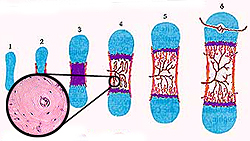Human Tissue Biology A464
 Bone
is the other specialized connective tissue in which extracellular
specializations for support are maximal within the limits required
for development and remodeling. There are two types of bone
development: Bone
is the other specialized connective tissue in which extracellular
specializations for support are maximal within the limits required
for development and remodeling. There are two types of bone
development:
-
Intramembranous
ossification gives rise to membrane bones, these being the
flat bones of the skull and parts of the mandible.
- This process involves the
deposition of bone matrix (osteoid) directly in regions
("membranes") of embryonic mesenchyme.
-
 Bones of the
extremities,
pelvis and vertebral column (cartilage bones) are formed by
endochondral ossification. Bones of the
extremities,
pelvis and vertebral column (cartilage bones) are formed by
endochondral ossification.
- This process involves the
replacement of a hyaline cartilage model with bone.
Regardless of the ossification process, the histological
structure of the bone is the same.
Learning Objectives:
- Understand the two mechanisms of
bone formation, their differences and similarities.
- Recognize the appearances and
significance of the various zones present in a bone.
- Recognize and know the
functional significance of the parts comprising a synovial joint
Let's look at some examples. |
|